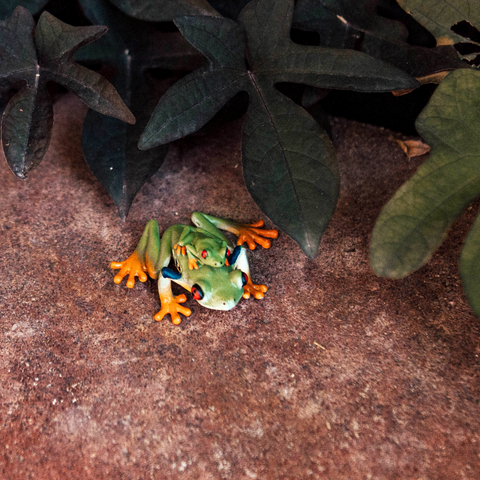March 20th is World Frog Day! It’s a day to celebrate these hop-happy amphibians all over the globe! We at Safari Ltd are getting into the Frog Day spirit, as we usually do, by putting together a list of Frog Fun Facts to help you learn more about these fascinating creatures.
First things first: what’s a frog? Frogs are amphibians – a class of animals with four legs that require wet habitats to keep their skin from drying out. Unlike birds and egg-laying reptiles, whose eggs are covered by protective membranes, the eggs of amphibians require water to maintain their structure. Because of this, most amphibians are aquatic or semi-aquatic, living in or near bodies of water. Frogs are separated from other amphibians by their unique bone structure and lack of tails.
Frogs have an interesting, water-dwelling larval stage known as a tadpole. Upon hatching from eggs, they have tails, no legs, and use gills to breathe underwater. Then they undergo a process called “metamorphosis” in which they grow lungs to breathe air and limbs to walk on land. Their tail also shrinks until it’s gone.
You may be wondering: What’s the difference between a frog and a toad? There are many common answers to this question. Typically, a frog has wet, smooth skin while a toad has dry, bumpy skin. Toads tend to spend more time on dry land while frogs are more aquatic. Frogs are also usually better at jumping, whereas toads tend to crawl or hop short distances. However, the true answer is that there is no real scientific difference between frogs and toads. Both are in the order Anura, and many toads have frog-like characteristics, while many frogs feature toad-like qualities.
Frogs are known for their vocalizations. They make croaks, chirps and other unique noises that are often quite loud thanks to a special membrane that they use to increase the volume of their call. Some frog species can be heard a mile away! These noises are usually used by male frogs to attract females for mating. During breeding season, in areas with lots of frogs, these calls can fill the air as thousands of male frogs compete for female attention.
Frogs first developed around 250 million years ago. Today, there are nearly 5,000 species of frog. Unfortunately, since the year 1980, may frog species have been rapidly declining, and over a hundred species are thought to have gone extinct entirely. The causes for this decline are not entirely known, but many theories have been suggested, from habitat destruction to pollution to fungal infection. It is believed that amphibians are becoming extinct at a rate up to 200 times higher than the total rate of animal extinction. In order to put a stop to this decline of frog populations, more research is needed. Thankfully, there are many scientists working hard to find the cause of this, so hopefully frogs will be around for many more World Frog Days to come!
Bernie’s Bonus Fun Fact: Frogs are well known for their jumping abilities. Some frogs, like the flying tree frog, can use webbing on their legs and feet to glide over short distances. The farthest jump by a non-gliding frog species is that of the striped rocket frog. It can jump well over six feet, or more than 50 times its own length.
Check out other frog products HERE




